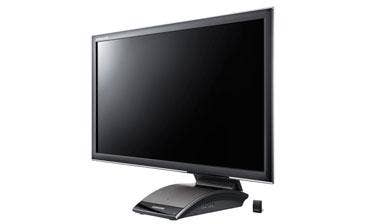Samsung Delivers Universal Docking Station

Finally! Someone has solved the problem of the obsolete docking station. Samsung Electronics in May will begin shipping Central Station, a universal docking station that wirelessly connects any Windows laptop to a high resolution display, Ethernet, USB and audio. Starting at $449 list price, including an integrated 23-inch LCD display, Central Station is aimed initially at consumers looking for the simplicity of a single point of connection for printers, scanners, and devices in need of recharging and for consumption of 1080p content.
Samsung expects interest on the consumer side to come from home-office workers and families looking for a simple homework station that offers permanent connections to a full-sized keyboard, mouse and other input and output resources. A 27-inch version also will be available, and will list for $599.
Sometime in June, Samsung will begin shipping 27-inch and 24-inch models for the enterprise. It's here that avoidance of docking station obsolescence might be most pertinent. Though B2B pricing has not been announced, Samsung expects that as with the consumer edition, the docking station-enabled monitor will bring a premium of about $200 over similar Samsung monitor alone. "A [laptop-specific] docking station costs about $100, so from a corporate buyer's perspective, if you don't have to replace it once, it's already paid for itself," said Evan Horowitz, Samsung's product manager for consumer displays.
Why hasn't anyone thought of this before? Now that we've gotten an understanding of exactly how Central Station works, we think others must have been scared away by the challenges. The solution includes a USB 2.0 dongle and one-time driver install, which "virtualizes all the elements" that make up Central Station, explained Horowitz.
Next: Samsung's Secret Sauce
Those elements include a 1080p display, four USB ports (two of which are USB 3.0), Ethernet and stereo audio. To Windows, it just appears as if those devices are connected locally, with all Windows-based settings applicable. But they're actually attached over a single, proprietary Ultra-wideband wireless protocol. "That's Samsung's secret sauce," said Horowitz, and represents the most challenging part of the solution. Range is rated about five feet, depending on the environment, but we saw it working just fine at about 12 feet. Either way, it's clearly better than having to connect cables or even to dock. Once the laptop is in range, it just works.
In the enterprise, Central Station would clearly be terrific for board rooms, conference rooms, visitor cubicles and the like. But Samsung believes it's a great choice for any mobile user. "With the great number of virtual users in corporations today, whoever comes into the office can easily connect and get all the resources they need regardless of the laptop maker," said Horowitz. With VGA and HDMI inputs, Central Station also can work as a conventional monitor, a KVM switch for two computers, and if a USB dongle is unavailable, laptops can still connect via one of its USB 3.0 ports.
Available in May for consumers and in June for the enterprise, Central Station works with Windows XP and and Windows 7; drivers for Vista and Mac OS X are scheduled for sometime after September and will work with the same hardware. Available in 27-inch and 23-inch models, consumer editions are built with a two-hinge stand and TN panels, and include Samsung's lean-back and side-view software settings, which compensate for the technology's limited viewing angle. Enterprise editions will feature a more conventional pneumatic pillar stand and be built with 27-inch and 24-inch PVA panels.